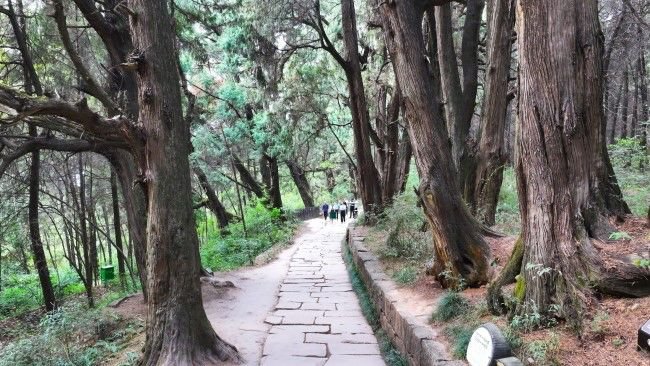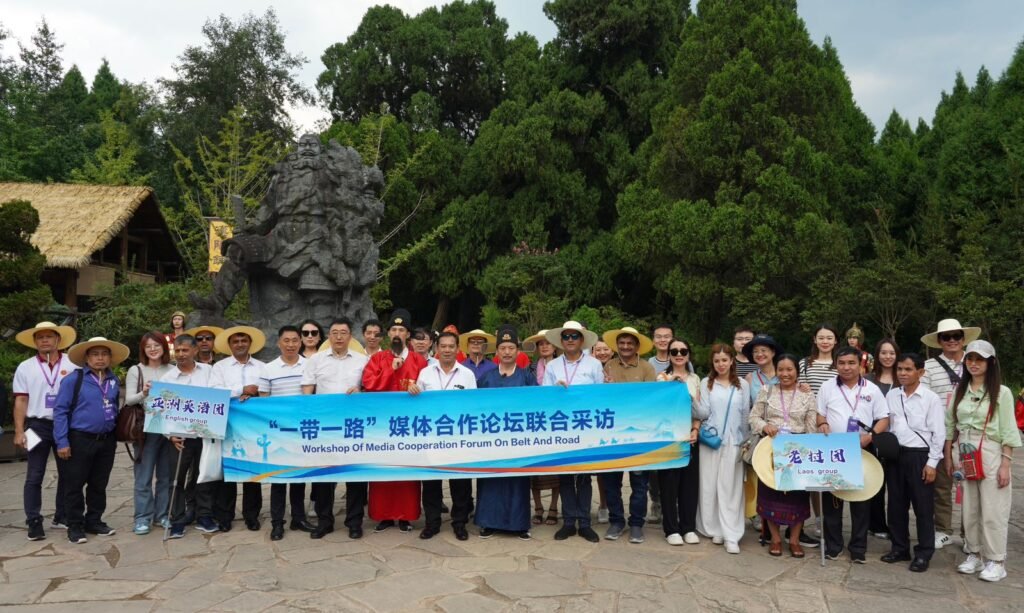Muhammad Asif Noor
The Cuiyun Corridor, nestled within the scenic and historically rich region of Guangyuan in Sichuan province, stands as a monumental testament to China’s enduring cultural and historical legacy.
This ancient pathway, stretching 151 kilometers, is not merely a route of travel but a living chronicle that encapsulates the essence of Chinese civilization spanning over 2,000 years.
Flanked by nearly 10,000 ancient cypress trees, the corridor is a vivid illustration of the symbiotic relationship between humanity and nature, offering a serene yet profound atmosphere where history whispers through the leaves.
The origins of the Cuiyun Corridor are rooted in the challenges faced by ancient Sichuan. The region, known as the “Land of Abundance,” boasted a mild climate and rich natural resources. However, its mountainous terrain created significant barriers to external communication and trade.
In response, the ancients embarked on the ambitious project of constructing the Shu Path, a series of roads that would connect Sichuan to the rest of China.
The Cuiyun Corridor, a key section of this network, was meticulously designed not only for its utility but also for its cultural and ecological significance.
As you walk along this ancient path, the history of renowned figures like Zhuge Liang, the brilliant strategist of the Three Kingdoms period, General Zhang Fei, and Emperor Xuanzong of the Tang Dynasty comes to life.
These historical figures once traversed this very route, their journeys contributing to the rich exchanges between Sichuan and the outside world.
The corridor has borne witness to countless significant events, from military campaigns to cultural exchanges, making it a vital artery in the history of Chinese civilization.
The construction of the Cuiyun Corridor was an extraordinary feat of both engineering and environmental foresight.
The ancients planted cypress trees along both sides of the road to mark its position and measure its length, resulting in a unique landscape that became known as the “100,000 trees on a 150-km road.”

These trees, now averaging over 1,000 years old, have grown into towering giants, with the oldest among them dating back more than 2,300 years.
One of the most revered trees, the Royal Cypress, stands 27 meters tall, its diameter greater than the height of an average man, symbolizing the corridor’s grandeur and the passage of time.
The history of the corridor is marked by six major tree planting campaigns, with particularly significant efforts during the Song Dynasty over 1,000 years ago and the Ming Dynasty more than 600 years ago.
These plantings were not just acts of reforestation but deliberate efforts to maintain the corridor as a living monument. The trees’ slow growth—taking 100 years to expand their trunks by just 10 centimeters—adds to their mystique and significance.
Their presence along the corridor serves as a constant reminder of the region’s deep-rooted connection to its past.
The corridor’s importance extends beyond its natural beauty and historical significance. It has played a crucial role in China’s political, military, cultural, and economic development over the centuries.
As a vital transportation route, the Cuiyun Corridor facilitated the movement of armies, the exchange of goods, and the dissemination of ideas.
The area around the corridor, particularly Jiange County, became a focal point for these activities, with its strategic location ensuring its prominence in China’s historical narrative.
In recognition of its significance, the Cuiyun Corridor has been designated a 5A-level scenic area, attracting visitors from across the country and around the world.
The lush mountains, clear waters, and profound cultural heritage make it a must-visit destination for those seeking to connect with China’s past. The corridor is not just a place to admire natural beauty but also a living classroom where visitors can learn about the intricate interplay between human endeavor and environmental stewardship.
The preservation of the corridor and its ancient trees is a testament to the dedication of the people of Jiange. As Yang Zubin, the Party chief of Jiange County, once said, “Even if the trees die, they cannot be felled.”
This commitment to preservation has ensured that the corridor remains as close to its original state as possible, allowing visitors to experience the same sights that historical figures like Zhuge Liang and Emperor Xuanzong once did.
Modern technology has further enhanced the preservation efforts. Every ancient tree in the Cuiyun Corridor now has its own ID card, which records crucial information such as its age and maintenance history.
Over a thousand forest rangers work tirelessly to protect this historical treasure, ensuring that the corridor continues to thrive for future generations.
These efforts highlight the enduring importance of the corridor, not just as a relic of the past but as a living, breathing part of China’s cultural landscape.
The Cuiyun Corridor also plays a significant role in the broader context of the Shu Path. This ancient road network, which includes famous routes like the Jinniu Road, Micang Road, and Yinping Road, was essential for connecting Sichuan with the rest of China.
Each of these roads has its own unique history and cultural significance, contributing to the rich tapestry of the Shu Path as a whole. The Jinniu Road, for instance, was the earliest established official postal route between Sichuan and Shaanxi, while the Micang Road served as a crucial shortcut to Hanzhong.
The corridor’s significance is further underscored by its association with the Three Kingdoms period, a time of great turmoil and heroism in Chinese history.
Guangyuan, the region where the corridor is located, was a major battlefield during this era, particularly in the conflicts between the states of Shu and Wei.
The Shu Path, including the Cuiyun Corridor, was not just a route for travelers but also a military highway, crucial in the strategic maneuvers that defined this tumultuous period.
The remnants of this history, including over 140 sites from the Three Kingdoms era, can still be found in Guangyuan today.
In addition to its military and transportation significance, the Cuiyun Corridor is a symbol of China’s ancient environmental consciousness.
The deliberate planting of cypress trees along the post road was not merely for aesthetic purposes but served practical functions such as protecting the road from erosion, providing shade, and offering shelter to travelers. This practice of integrating natural elements into infrastructure reflects a deep respect for nature that is characteristic of Chinese culture.
As we traverse this ancient path today, the Cuiyun Corridor continues to captivate and inspire. It serves as a bridge between the past and the present, a place where the echoes of history can still be heard and where the natural beauty of ancient China remains preserved.
The corridor is more than just a scenic route; it is a living testament to the resilience of nature, the wisdom of ancient environmental practices, and the enduring legacy of Chinese civilization.
The Cuiyun Corridor is a remarkable blend of natural beauty, historical significance, and cultural depth.
It stands as a testament to China’s enduring legacy, offering insights into the ancient world’s sophisticated systems of transportation, communication, and environmental management.
Whether you are a historian, a nature lover, or a curious traveler, the Cuiyun Corridor offers an unforgettable journey through time, where every step echoes with the voices of the past, and every tree tells a story of resilience, continuity, and the profound connection between humanity and nature.
*The writer is Editor-In-Chief of The Diplomatic Insight and Director of the Centre for BRI and China Studies at the Institute of Peace and Diplomatic Studies. The writer is currently in China for the 2024 Media Cooperation Forum on Belt and Road, organised by People’s Daily.
Established in December 2008, The Diplomatic Insight is Pakistan’s premier diplomacy and foreign affairs magazine, available in both digital and print formats.








